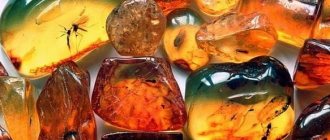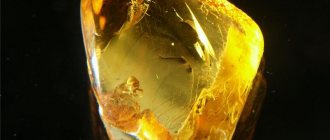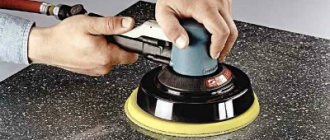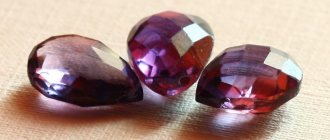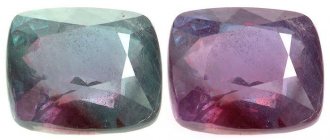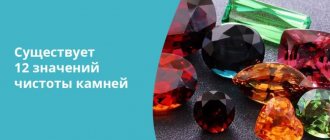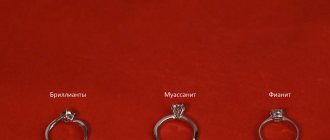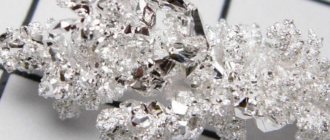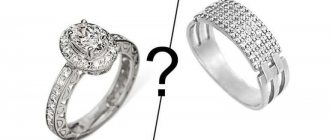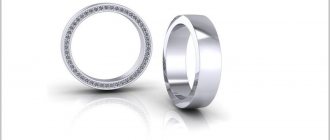| Stone type | Semiprecious |
| Prevalence (Deposits) | Austria, Brazil, Germany, Russia, North America, Sri Lanka |
| Varieties | Ametrine, brandberg, lavender amethyst, proselytes, rutile amethyst, chevron |
| Transparency | Transparent |
| Shine | Glass |
| Mohs hardness scale | 7 |
| Chemical composition | SiO2 |
| Color | Green, Pink, Purple, Black |
| Owner's color type | Summer |
| Owner's temperament | Sanguine, phlegmatic, choleric |
| Names | Andrey, Antonina, Arkady, Arseny, Valeria, Varvara, Venus, Violetta, Vsevolod, Denis, Dmitry, Evgeny, Elizaveta, Leonid, Lydia, Lyudmila, Maxim, Marina, Maria, Oleg, Regina, Renata, Roman, Semyon, Elvira |
| Zodiac sign | Gemini, Libra, Aquarius |
| Date of Birth | from May 21 to June 21 from September 23 to October 23 from January 21 to February 18 |
| Chinese horoscope | Rat, horse, tiger |
| Element | Air |
| Planet | Venus, Neptune, Saturn |
| Day of the week | Thursday |
| Month | February, December |
| Season | Winter |
| Numerology vibration | 3, 8 |
| Chakra | Ajna, Sahasrara |
| What stones is it compatible with? | Rock crystal, emerald, labradorite, moonstone |
| What stones is it not compatible with? | Beryl, malachite, sardonyx |
| Therapeutic effect (problems) | Insomnia, pain, spasms, vision, nervous disorders, stress |
| Therapeutic effect (on organs) | Organs of the gastrointestinal tract, hearing organs, cardiovascular system, joints |
| Magic properties | Spiritual development, energy depletion |
Amethyst is one of the most popular varieties of quartz.
Despite its quite affordable price, this stone also did not escape the fate of imitation. You can distinguish natural amethyst from a fake even at home. To do this, you need to have an idea of the physical properties of the amethyst stone and its appearance. The palette of amethyst shades is very diverse: from lilac-pink to violet. The latter color even gave a new name to the mineral “stone violet”.
This type of quartz rock is considered the most attractive by jewelers. And it’s not only about the appearance and shade spectrum, but also about color reverse – the ability to change shade under artificial lighting.
The price of a mineral is also affected by the degree of its transparency. Translucent stones with a richer tone are more expensive than clear crystals of the same type.
Be sure to watch: Assessing the purity and quality of diamonds: characteristics and tables
Green amethyst (prasiolite) is practically never found in nature. Most often, the emerald hue is recreated in laboratories by irradiating or heating ordinary amethyst. It looks like ordinary beryl. Prasiolite is often used as an imitation of expensive precious stones.
The darkest shade is characteristic of amethysts mined on the Kola Peninsula. They are also the most expensive minerals of this type.
Methods for detecting counterfeit
Although the mineral is quite common in nature, due to the popularity of amethyst, its fakes are often found. If you buy silver or gold jewelry with a stone or have inherited it, you can determine for yourself what the inserts are made of. In this case, the properties of a natural gem are taken into account, so professional tools are not needed.
Visually visible parameters
Pay attention to:
- Brightness. Artificial stone has a uniform color, without inclusions. The real one is dim, uneven, slightly cloudy. Microcracks and bubbles are visible through a magnifying glass.
- Color. Fakes usually have very “loud” shades. The real one has noble purple ones.
- Transparency. Natural mineral transmits light unevenly. When lighting changes, the color of natural jewelry does not change.
- Jewelry processing. How to distinguish a fake based on it? The fake has a perfect polish. In natural stone, the girdle (the band located between the lower and upper parts) is always slightly rough.
Remember that jewelry with a solid frame, rather than an openwork frame, should be viewed under directional light.
Physical properties
You will learn how to distinguish an amethyst from a fake in this section.
Simple methods for recognizing the naturalness of a stone:
- Water. It will allow you to distinguish natural stone from all fakes, including grown ones. You need to place it in a transparent container filled with water at room temperature. After 2 minutes, natural amethyst will become pale around the edges.
- UV range. The distinctive quality of a natural gem is that under the rays of the sun or under an ultraviolet lamp, the entire color fades evenly. The fake one will become spotted and fade in places.
- Thermal conductivity. For stones mined from natural deposits, it is small. Hold the sample in your hands or place it on a warm cheek. The fake one will heat up quickly, but the real one will remain cold for a long time, then it will become a little warmer. It's good if you already have a stone whose origin is known. Then you just need to take both at once and notice which one warms up faster.
- Strength. Natural and artificially created amethysts are very hard and cannot be damaged by a knife or needle. They themselves are capable of scratching porcelain, earthenware, etc. This test is good because it will reveal a glass or plastic imitation of a crystal.
Quartz structure
It is more convenient to examine the structure of stones using a 10x magnifying glass or a microscope, better than a jewelry one.
- A real gem, unlike an artificial one, has microcracks and irregularly shaped bubbles. They are usually visible to the naked eye. A sample grown artificially will show curved grooves (these are crystal growth lines).
- The mineral from the deposit contains small crystals of different colors. This zoning can be distinguished under a microscope.
If the specimen is light, you need to turn on the inversion mode for viewing under the microscope.
Description of amethyst
Natural amethyst is one of the varieties of quartz.
Officially, amethyst is a type of quartz. It has a red-violet, bluish-pink or blue color, less often green. Transparent specimens are classified as semi-precious, while opaque specimens are classified as ornamental minerals.
Natural amethyst contains inclusions, most often in the form of tubes. Less commonly, the stone contains impurities of goethite or hematite. Such varieties are called hairy.
A distinctive feature of amethyst is its ability to slightly change color depending on the lighting. The resistance of stones to light varies: gems found in crystal-bearing veins can withstand even direct sunlight well.
Amethysts from sedimentary rock geodes fade quickly. At high temperatures the stone becomes discolored. Unscrupulous grinders take advantage of this. They pass off bleached amethysts as topazes and aquamarines.
The stone has a pearlescent luster. It is characterized by the absence of cleavage. Hardness on the Mohs scale is 7 points, like other varieties of quartz.
Amethyst can be cut with diamond and will scratch glass. It cannot be damaged by hematite, lapis lazuli or opal. However, rubies, sapphires, topazes, aquamarines and spinels can leave scratches on the surface of amethyst.
What does natural stone look like?
Real amethyst is a valuable type of quartz, a hard mineral of blue-violet color in various shades - from light lilac to dark violet. Color saturation affects the cost. The stone grows on a gray quartz base in the form of elongated crystals resembling sceptres, 5-100 mm long, or in the form of individual druses.
Green colored gemstones called prasiolites are found in nature. This is a rare occurrence, so burnt quartz is often sold under the guise of a real stone. Natural green prasiolite is mined only in Brazil and America.
What are analogues made from?
Amethyst is one of the most popular gemstones. Its name comes from the Greek “amethyst,” which means “not drunk,” which is why many people attribute magical and healing properties to it. It is for them that the naturalness of this crystal is fundamentally important. Fake stones are made from:
- plastic;
- glass;
- cheap or defective natural stones;
- tinted crystal.
Synthetic amethyst can hardly be called a fake, since it is grown artificially from the same mineral as the original. Natural amethyst differs from a fake in that it contains gas-liquid inclusions and small cracks. These defects are almost invisible to the naked eye, but give the stone a special beauty.
History and origin of the mineral
The name of the stone comes from an ancient legend. The god of wine and fun, Dionysus, fell in love with a beautiful nymph named Amethys. But the nymph was indifferent to Dionysus, despite all his attempts at seduction. Then the goddess Artemis, as a sign of solidarity with Dionysus, decided to punish the rebellious Amethys and turned her into a purple gem. To this day, amethyst is credited with magical properties to protect against drunkenness.
According to another belief, in ancient times a man gave a stone to his wife to preserve love. If the husband died, the widow wore an amethyst ring as a sign of eternal love.
This is connected with a legend where one day one woman’s husband did not return home. She lost peace, abandoned her home, everyday life, and children. She waited and searched, but to no avail. One morning the woman went to the sea and disappeared, and purple gems were discovered on the shore.
According to scientific data, amethyst has been revered by the clergy since ancient times. The priests of the Middle Ages decorated their clothes, icons, crosses and other church paraphernalia with them. Since the 18th century, ordinary people were allowed to wear jewelry.
- In Ancient Greece, crowns and cups were inlaid with stone.
- In Italy they put a stone in a glass of wine.
- In Russia, representatives of the nobility emphasized their status with the help of amethyst jewelry.
- Crafts were made in China, Ancient Greece, and Ancient Rome.
Main conclusions
Amethyst is one of the most visually attractive stones. At the same time, it is quite affordable from a financial point of view. However, this does not stop numerous “masters” trying to sell glass or transparent plastic under the guise of this gem.
- This variety of quartz is characterized by a deep, dark purple color that may reflect slightly under artificial light.
- Most often, synthetic crystals and anthozonite are passed off as natural amethyst.
- A natural mineral can be distinguished by its thermal conductivity, strength, weight and transparency.
- Professional evaluation includes ultraviolet, x-ray and spectral analysis.
Jewelry with amethyst can leave few people indifferent. This crystal is often combined with other valuable stones, which is why it is so important to learn how to identify a fake before purchasing a product.
What do they offer instead of a gem?
Most often, colored plastic, glass, artificial stones and natural gems that are similar in appearance but of a lower class are sold under the guise of amethyst.
Colored plastic is the cheapest and most obvious type of counterfeit. Even a layman can distinguish plastic from natural stone. Identifying glass imitation is no more difficult. It is distinguished by great fragility. The glass surface can be easily scratched with a regular sewing needle, but this will not happen with a natural gem.
Interesting! Artificial crystals are grown on a quartz base. They have a natural base and practically do not differ in their physical characteristics and appearance from the originals, so they can be called a fake very conditionally. However, it is believed that this type of cultivated gems does not have healing and magical qualities.
As for natural analogues, most often the “twin” of amethyst is the mineral fluorite.
Amethyst stone - matte Which zodiac sign is the amethyst stone suitable for: Amethyst is suitable to varying degrees for almost...
Published by Kamnegid.ru - Natural stones Monday, February 18, 2022
Synthetic or natural?
The jewelry market is dominated by artificially created amethysts. This is an intermediate stage between natural stone and synthetic stone; a fake is considered conditionally. The price of copies of comparable parameters does not differ much.
Amethyst
Their advantages: it is impossible to visually distinguish them from a natural crystal, they are unpretentious in use and care, they are indifferent to the sun, and constant wearing does not harm jewelry.
They do not work as a magical or healing artifact, but are suitable for all zodiac signs.
| Zodiac sign | Compatibility (“+++” – fits perfectly, “+” – can be worn, “-” – strictly contraindicated) |
| Aries | +++ |
| Taurus | + |
| Twins | + |
| Cancer | + |
| a lion | — |
| Virgo | + |
| Scales | + |
| Scorpion | + |
| Sagittarius | + |
| Capricorn | + |
| Aquarius | +++ |
| Fish | + |
You can choose jewelry with artificial and natural stones. To please yourself with some whenever you want, to leave others for special occasions, passing them on as a family treasure.
Rules of care
Amethysts are hard gemstones and hence safe for everyday wear. However, there are several recommendations that should be followed to ensure that the crystals retain their bright color longer:
- polish your jewelry from time to time to prevent scratches;
- do not allow the stones to be exposed to bright sunlight for a long time - this can lead to fading of the mineral, its color will become dull and unattractive;
- It is important to carefully protect amethyst jewelry from sudden temperature changes. Despite the fact that this stone is durable, microcracks may appear on it;
- Amethyst jewelry should be cleaned regularly using warm soapy water and a soft toothbrush.
Amethyst is a beautiful precious (semi-precious) stone, which, despite its low cost, is often counterfeited. Replace with synthetic specimens or tinted crystal. Sometimes it is difficult to distinguish an original from a fake, so in order to be sure of the authenticity of a piece of jewelry, you need to order a jewelry examination.
Professional inspection methods
Professional testing methods include spectral and x-ray diffraction analyses. They turn to laboratories when trying to distinguish natural stone from synthetic stone. Glass and plastic samples can be detected upon self-examination.
Spectral and X-ray diffraction analyzes
The spectrometer is a light source. With its help, you can determine the refractive index, study impurities, and even distinguish natural stone from artificial stone.
Thanks to the light, the specialist sees foreign inclusions, synthetic resins, organic compounds, etc. This method allows you to assess the authenticity of gems in a non-destructive way, including as part of jewelry, if the setting is not solid. Using a spectrometer, artificial coloring can be detected.
X-ray diffraction analysis determines the structure of the stone and the impurities that make up its composition. With its help, you can establish the authenticity of not only the gem, but also the metal of the frame.
This method also does not require destruction of the product or stone. To obtain a more reliable result, it is recommended to combine several methods.
